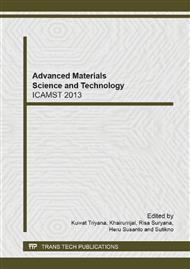[1]
J.W. Lee, S.P. Choi , R. Thiruvenkatachari, W.G. Shim, H. Moon, Evaluation of the performance of adsorption and coagulation processes for the maximum removal of reactive dyes, Dyes Pigments 69 (2006) 196-203.
DOI: 10.1016/j.dyepig.2005.03.008
Google Scholar
[2]
G. Crini, Non-conventional low-cost adsorbents for dye removal: A Review, Bioresour. Technol. 97 (2006) 1061–1085.
DOI: 10.1016/j.biortech.2005.05.001
Google Scholar
[3]
S. Pirillo, V. Pedroni, E. Rueda, Elimination of dyes from aqueous solution using iron oxides and chitosan as adsorbents. A comparative study, Quim. Nova, 32(2009) 1239-1244.
DOI: 10.1590/s0100-40422009000500030
Google Scholar
[4]
M. Rafatullah, O. Sulaiman, R. Hashim, A. Ahmad, Adsorption of methylene blue on low-cost adsorbents: A review, J. Hazard. Mater. 177 (2010) 70–80.
DOI: 10.1016/j.jhazmat.2009.12.047
Google Scholar
[5]
L. T. Zhuravlev, Colloids and Surfaces A: Physicochem. Eng. Aspects, The surface chemistry of amorpous silica. Zhuravlev model, 173 (2000) 1–38.
DOI: 10.1016/s0927-7757(00)00556-2
Google Scholar
[6]
R.K. Iller, The Chamistry of Silica, John Wiley &Sons, (1979).
Google Scholar
[7]
T. Zuyi, C. Taiwei, L. Weijuan, D. Jinzhou, D. Xiongxin, G. Yingjie, Cation adsorption of NpO2+, UO2+, Zn2+, Sr2+, Sr2+, Yb3+, and Am3+ onto oxides of Al, Si, and Fe from aqueous solution: ionic strength effect, Colloids and Surfaces A: Physicochem. Eng. Aspects 242 (2004).
DOI: 10.1016/j.colsurfa.2004.04.044
Google Scholar
[8]
M. Anbia, S. A. Hariri, S.N. Ashrafizadeh, Adsorption removal of anionic by modified nanoporous silica SBA3, Appl. Surfa. Sci, 256 (2010) 3228-3233.
DOI: 10.1016/j.apsusc.2009.12.010
Google Scholar
[9]
X. Chen and S. S. Mao, Titanium dioxide nanomaterials: Synthesis, properties, modification, and aplications, Chem. Rev. 107 (2007) 2891.
Google Scholar
[10]
S. H Lim, E.J. Woo, H. Lee, C. H Lee, Synthesis of magnetite-mesoporous silica composites as adsorbents for desulfurization from natural gas, Appl. Catal. B: Environ. 85 (2008) 71-76.
DOI: 10.1016/j.apcatb.2008.06.028
Google Scholar
[11]
W. Deligeer, Y.W. Gao, S. Asuha, Adsorption of methyl orange on mesoporous Fe2O3/SiO2 nanocomposites, Appl. Surf. Sci. 257 (2011) 3524–3528.
DOI: 10.1016/j.apsusc.2010.11.067
Google Scholar
[12]
M. Emadi, E. Shams, M.K. Amini, Removal of Zinc from aqueous solution by magnetite silica core-shell nanoparticles, J. Chem. 2013, article ID 787682, 10 pages.
DOI: 10.1155/2013/787682
Google Scholar
[13]
F.L. Fan, Z. Qin, J. Bai, W.D. Rong, F.Y. Fan, W. Tian, X.L. Wu, Y. Wang, L. Zhao, Rapid removal of uranium from aqueous solution using magnetic Fe3O4@SiO2 composite particles, J. Environ. radioact. 106 (2012)40-46.
DOI: 10.1016/j.jenvrad.2011.11.003
Google Scholar
[14]
Y.S. Kang, S. Risbud, J.F. Rabolt, P. Stroeve, Synthesis and characterization of nanometer-size Fe3O4 and -Fe2O3 particles, Chem. Mater. 8 (1996) 2209-2211.
DOI: 10.1002/chin.199702030
Google Scholar
[15]
X. Zhao, Y. Shi, T. Wang, Y. Cai, G. Jiang, Preparation of silica-magnetite nanoparticles mixed hemimicelle sorbents for extraction of several typical phenolic compounds from environmental water samples, J. Chromatography A, 1188 (2008) 140-147.
DOI: 10.1016/j.chroma.2008.02.069
Google Scholar
[16]
D. Yang, J. Hu, and S. Fu, Controlled Synthesis of magnetite-silica nanocomposites via seeded sol-gel approach, J. Phys. Chem. C, 113 (2009) 7646-7651.
DOI: 10.1021/jp900868d
Google Scholar
[17]
D. Makovec, M. Sajko, A. Selisnik, M. Drofenik, Low-temperature synthesis of magnetically recoverable, superparamagnetic, photocatalytic, nanocomposite particles, Mat. Chem. Phys. 136 (2012) 230-240.
DOI: 10.1016/j.matchemphys.2012.06.058
Google Scholar
[18]
K. Kaneko, Determination of pore size and pore size distribution: 1. Adsorbents and catalysts, J. Memb. Sci. 96 (1994) 59-89.
DOI: 10.1016/0376-7388(94)00126-x
Google Scholar
[19]
P. Simoncic, T. Armbruster, Cationic methylene blue incorporated into zeolite mordenite-Na: a single crystal X-ray study, Micropor. Mesopor. Mater. 81 (2005) 87-95.
DOI: 10.1016/j.micromeso.2005.01.019
Google Scholar


